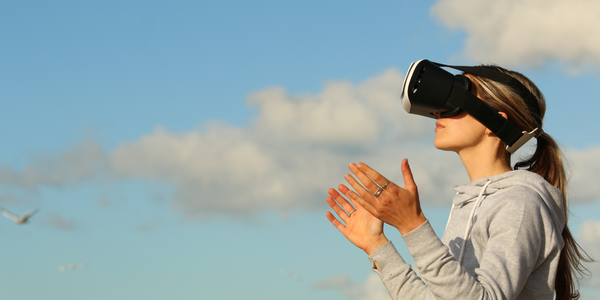Augmented Reality

Augmented Reality or enhanced Virtual Reality, is a technology that seamlessly integrates real-world information and virtual world information. The real environment and virtual objects can be superimposed on the same picture or space in real time. Augmented Reality technology can incorporate virtual information (objects, pictures, videos, sounds, etc.) into the real environment, enrich the real world and build a more comprehensive surrounding. Industry can benefit from AR by facilitating the equipment maintenance, guiding the production and manufacturing process of commodities, and improving the marketing champions.
1. Enhancing Customer Engagement and Experience: AR offers businesses unique opportunities to engage customers in immersive and interactive experiences, enhancing brand loyalty and driving sales. By integrating AR features into mobile apps, product packaging, and marketing materials, businesses can offer customers interactive product demonstrations, virtual try-on experiences, and personalized shopping recommendations. AR enables businesses to create memorable and engaging experiences that differentiate their brand and foster customer loyalty in competitive markets.
2. Improving Training and Education: AR technology provides businesses with innovative tools for employee training, onboarding, and skills development. By leveraging AR-enabled training modules and simulations, businesses can provide employees with hands-on learning experiences in virtual environments, reducing training time and costs. AR-enhanced training programs enable employees to learn complex procedures, operate machinery, and troubleshoot equipment in a safe and interactive manner, leading to improved performance, productivity, and job satisfaction.
3. Optimizing Field Service and Maintenance: In industries such as manufacturing, construction, and utilities, AR technology is transforming field service and maintenance operations by providing technicians with real-time access to contextual information and remote expertise. AR-enabled smart glasses or mobile devices overlay relevant data, instructions, and visualizations onto the technician's field of view, guiding them through complex tasks and facilitating remote collaboration with experts. AR-powered maintenance workflows improve efficiency, accuracy, and safety, minimizing downtime and enhancing asset reliability.
1. Customers and End Users: Customers and end users are essential stakeholders in AR initiatives as they directly interact with AR applications and experiences. Their viewpoint focuses on the usability, accessibility, and value proposition of AR solutions. Customers seek AR experiences that enhance their shopping, entertainment, or learning experiences, providing added convenience, entertainment value, or educational benefits. They expect AR applications to be intuitive, immersive, and seamlessly integrated into their existing workflows or activities. Customer feedback and satisfaction are crucial metrics for evaluating the success of AR initiatives from a user perspective.
2. Business Owners and Executives: Business owners and executives play a strategic role in driving AR initiatives within their organizations. Their viewpoint emphasizes the potential business impact, return on investment (ROI), and alignment with organizational goals. Business owners seek AR solutions that deliver tangible benefits, such as increased sales, improved operational efficiency, or enhanced brand perception. They evaluate AR initiatives based on their ability to drive revenue growth, reduce costs, or gain a competitive advantage in the marketplace. Business executives prioritize investments in AR technologies that align with the organization's strategic objectives and deliver measurable business outcomes.
Hardware Platforms and Devices: AR experiences are delivered through a variety of hardware platforms and devices, including smartphones, tablets, smart glasses, head-mounted displays (HMDs), and wearable devices. These devices feature integrated sensors such as cameras, accelerometers, gyroscopes, and depth sensors, which enable spatial tracking, motion detection, and environmental mapping. Stakeholders must evaluate the capabilities, specifications, and form factors of AR hardware platforms to ensure compatibility, performance, and user experience optimization.
Tracking and Localization Technologies: Tracking and localization technologies play a critical role in AR applications by enabling precise positioning and orientation of virtual content within real-world environments. AR systems utilize techniques such as marker-based tracking, markerless tracking, simultaneous localization and mapping (SLAM), and global positioning system (GPS) to track user movements, detect surfaces, and anchor virtual objects in physical space. Stakeholders must assess the accuracy, reliability, and latency of tracking technologies to deliver seamless and immersive AR experiences across different contexts and environments.
Rendering Engines and Graphics Libraries: Rendering engines and graphics libraries are essential components of AR software development, responsible for rendering virtual content, applying visual effects, and optimizing rendering performance. AR applications leverage 3D rendering engines such as Unity3D, Unreal Engine, and ARKit/ARCore SDKs to create realistic and immersive graphics. These engines support features such as real-time rendering, lighting, shading, and physics simulations, enabling developers to create compelling AR experiences with high-fidelity visuals and interactive elements.
1. Content Creation and Management: AR applications rely on a diverse range of content, including 3D models, images, videos, animations, and spatial mapping data. Stakeholders involved in content creation and management must ensure the availability, quality, and compatibility of content across AR platforms and devices. They leverage data repositories, content management systems (CMS), and digital asset libraries to store, organize, and distribute AR content efficiently. Metadata, tagging, and version control mechanisms facilitate content discovery, retrieval, and reuse, enabling stakeholders to streamline content creation workflows and optimize AR experiences.
2. User Interaction and Behavior Tracking: AR applications capture and analyze user interactions, gestures, and behaviors to personalize experiences, optimize usability, and track engagement metrics. Stakeholders leverage user tracking data, session logs, and analytics tools to monitor user interactions, identify usage patterns, and measure the effectiveness of AR experiences. They employ techniques such as heatmaps, clickstream analysis, and A/B testing to gain insights into user behavior, preferences, and pain points, informing iterative improvements and refinements to AR applications.
1. Hardware Compatibility and Fragmentation: AR experiences rely on compatible hardware devices equipped with sensors, cameras, and processing capabilities. However, the fragmentation of hardware platforms and operating systems poses a challenge for developers and stakeholders. Ensuring compatibility across a diverse range of devices, including smartphones, tablets, smart glasses, and head-mounted displays (HMDs), requires extensive testing, optimization, and platform-specific development. Addressing hardware fragmentation challenges involves selecting target platforms strategically, prioritizing compatibility, and adapting AR applications to different form factors and device specifications.
2. Software Development Complexity: Developing AR applications involves overcoming technical complexities related to software development frameworks, toolkits, and programming languages. AR developers must navigate a rapidly evolving landscape of development platforms, APIs, and SDKs, each with its own set of features, limitations, and learning curves. Integrating AR functionality into existing software ecosystems, such as mobile apps, games, and enterprise systems, requires expertise in 3D graphics, computer vision, and spatial computing. Addressing software development challenges involves investing in developer training, adopting standardized development practices, and leveraging cross-platform development tools to streamline the development process and accelerate time-to-market.
3. Content Creation and Asset Management: Content creation is a critical component of AR deployment, requiring stakeholders to generate, curate, and manage a diverse range of digital assets, including 3D models, textures, animations, and audiovisual content. However, creating high-quality AR content involves specialized skills, tools, and resources, often leading to challenges related to content creation workflows, scalability, and asset management. Addressing content creation challenges involves investing in content creation tools, outsourcing content production to specialized agencies or freelancers, and implementing content management systems (CMS) to organize and distribute digital assets efficiently.
4. User Experience Design and Usability: User experience (UX) design plays a crucial role in the success of AR applications, as intuitive and engaging experiences are essential for user adoption and satisfaction. However, designing effective AR user interfaces (UI) and interactions poses challenges related to spatial mapping, gesture recognition, and user guidance. Balancing usability, immersion, and performance requires iterative design, usability testing, and feedback gathering from end users. Addressing UX design challenges involves conducting user research, prototyping AR experiences, and refining UI/UX designs based on user feedback to create intuitive and user-friendly AR applications.
Case Studies.





